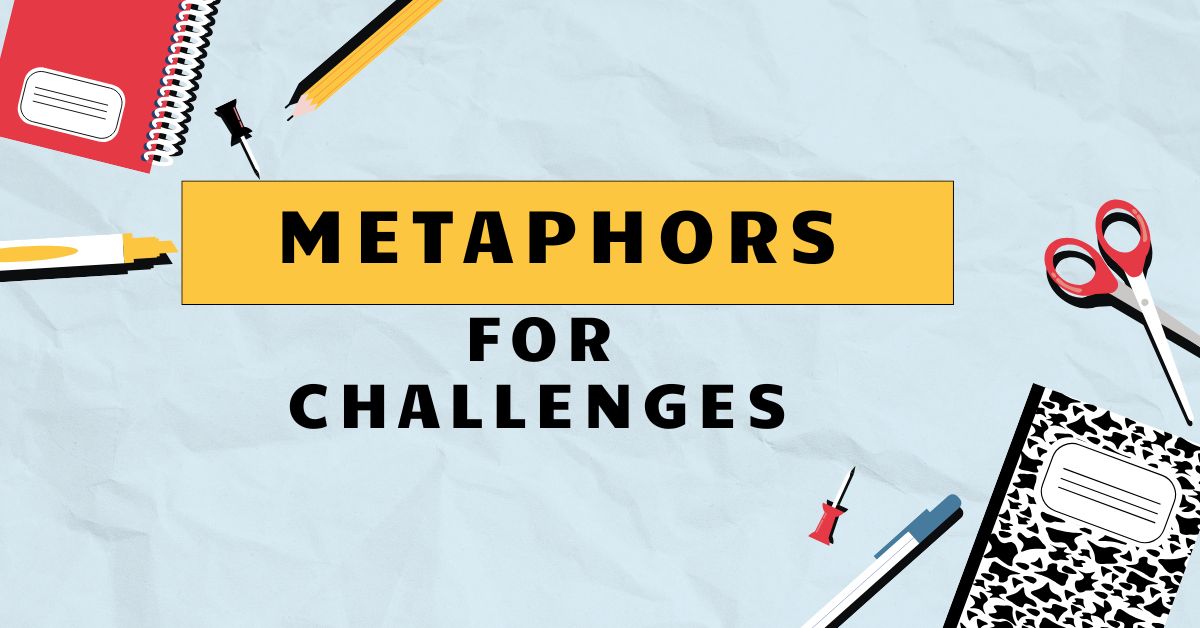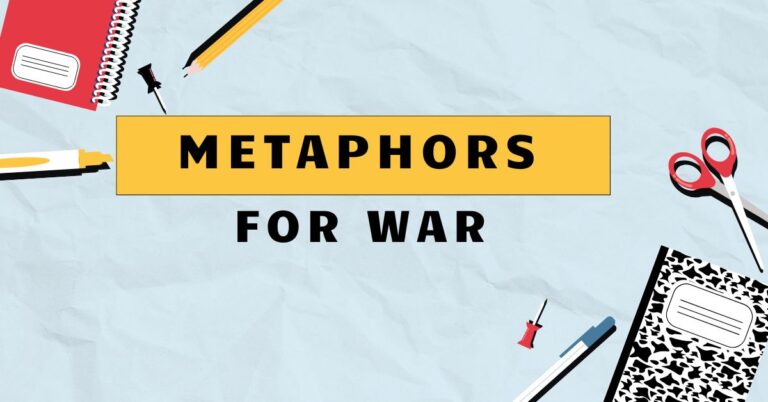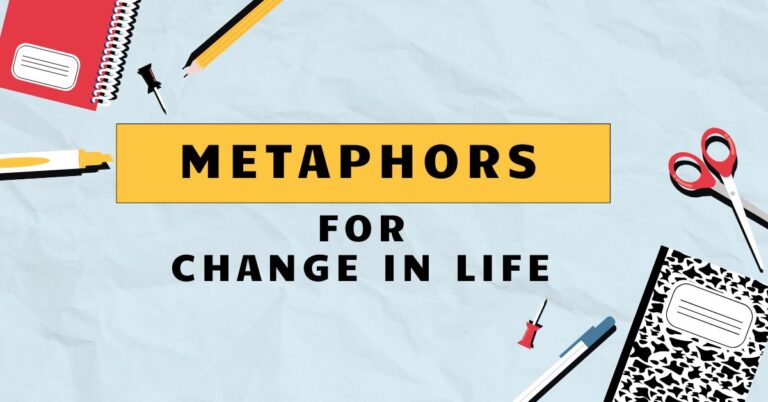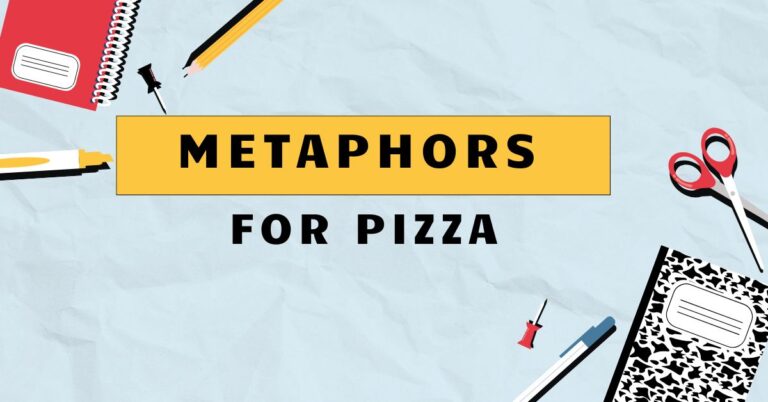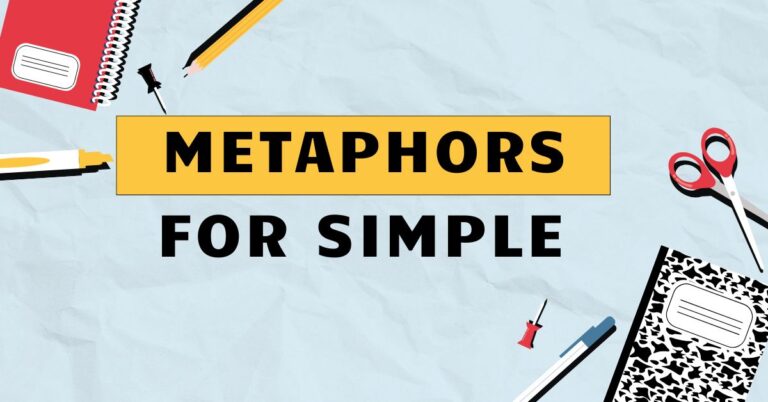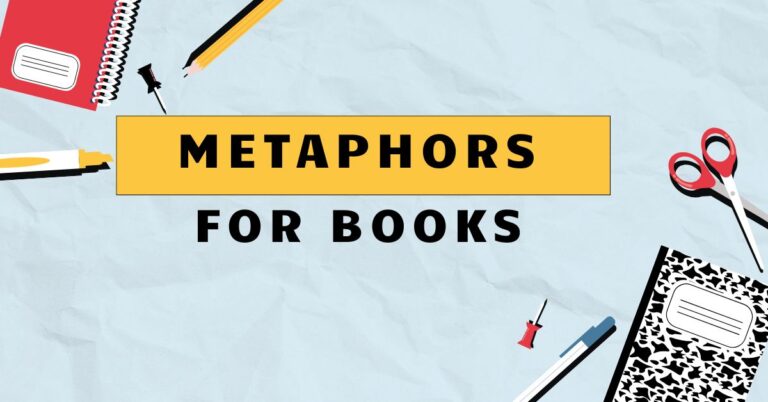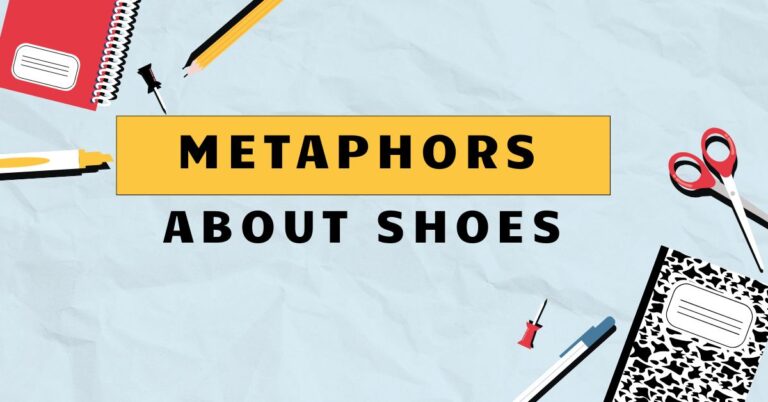33 Metaphors For Challenges: A Comprehensive Guide
Challenges are an inherent part of life, and how we perceive and articulate them significantly impacts our approach to overcoming them. Metaphors serve as powerful tools to frame these challenges, providing us with alternative perspectives and emotional connections.
Mastering the use of metaphors for challenges not only enhances our communication skills but also deepens our understanding of the obstacles we face. This guide is designed for students, writers, and anyone looking to enrich their language and gain a more nuanced understanding of the challenges they encounter.
By exploring the various types of metaphors and their applications, readers will gain a toolkit for expressing and interpreting challenges in more creative and meaningful ways.
Table of Contents
- Definition of Metaphors for Challenges
- Structural Breakdown of Metaphors
- Types and Categories of Metaphors for Challenges
- Examples of Metaphors for Challenges
- Usage Rules for Metaphors
- Common Mistakes When Using Metaphors
- Practice Exercises
- Advanced Topics: Extended Metaphors and Symbolism
- Frequently Asked Questions
- Conclusion
Definition of Metaphors for Challenges
A metaphor is a figure of speech that directly compares two unrelated things, asserting that one thing *is* another, not literally, but for rhetorical effect. When applied to challenges, metaphors help us frame difficulties in relatable and understandable terms.
These metaphors can influence our perception, emotional response, and problem-solving strategies. The function of a metaphor is to transfer qualities or associations from one concept (the source) to another (the target), thereby enriching our understanding of the target.
Metaphors for challenges appear in various contexts, including literature, everyday conversation, business communication, and personal reflections.
For example, saying “The challenge was a mountain to climb” doesn’t mean there was an actual mountain. Instead, it implies that the challenge was difficult, requiring significant effort and perseverance, similar to climbing a mountain.
This metaphor taps into our shared understanding of mountain climbing as a strenuous and demanding activity.
Structural Breakdown of Metaphors
Metaphors consist of two primary components: thetenor(or target) and thevehicle(or source). The tenor is the subject to which metaphorical attributes are ascribed, while the vehicle is the concept from which those attributes are borrowed.
In the example “The challenge was a mountain,” ‘challenge’ is the tenor, and ‘mountain’ is the vehicle. The connection between the tenor and vehicle is theground, which represents the shared characteristics or associations that make the metaphor meaningful.
Understanding the structural elements of a metaphor allows us to analyze how it creates meaning and affects interpretation. A well-constructed metaphor leverages the ground to create a resonant and insightful comparison.
The strength of a metaphor lies in its ability to evoke vivid imagery and emotional responses, leading to a deeper understanding of the subject at hand. The effectiveness of a metaphor also depends on the audience’s familiarity with the vehicle; a metaphor using obscure references may not resonate as intended.
Types and Categories of Metaphors for Challenges
Metaphors for challenges can be categorized based on the types of imagery and associations they evoke. Here are some common categories:
Obstacle Metaphors
Obstacle metaphors represent challenges as barriers or impediments that must be overcome. These metaphors emphasize the difficulty and obstruction aspects of the challenge.
Journey Metaphors
Journey metaphors frame challenges as a path or voyage with a destination. They highlight the process, progress, and potential for growth inherent in facing challenges.
Weather Metaphors
Weather metaphors use atmospheric conditions to describe the nature of the challenge. These metaphors often convey the unpredictability, intensity, and emotional impact of the challenge.
Battle Metaphors
Battle metaphors portray challenges as a conflict or struggle, emphasizing the effort, strategy, and potential for victory or defeat.
Weight Metaphors
Weight metaphors use the concept of heaviness or burden to describe the difficulty and emotional toll of challenges.
Natural Disaster Metaphors
Natural disaster metaphors depict challenges as catastrophic events, highlighting their destructive power and overwhelming nature.
Examples of Metaphors for Challenges
The following sections provide detailed examples of each type of metaphor, illustrating their usage and impact.
Obstacle Metaphors Examples
Obstacle metaphors vividly depict challenges as barriers that must be overcome. The following table provides examples of this type of metaphor.
These metaphors emphasize the difficulty and obstruction aspects of the challenge.
| Metaphor | Explanation |
|---|---|
| The project was a brick wall in her career. | The project presented an insurmountable obstacle, blocking career progression. |
| His lack of education was a glass ceiling. | His education limited his potential, preventing him from advancing further. |
| The bureaucracy was a labyrinth. | Navigating the bureaucratic system was confusing and complex. |
| The criticism felt like a slap in the face. | The criticism was harsh and unexpected, causing emotional pain. |
| The regulations were a minefield for the company. | The regulations posed numerous hidden dangers and risks. |
| The competition was a high hurdle. | The competition was difficult to overcome, requiring significant effort. |
| The language barrier was a chasm between them. | The language barrier created a significant divide, hindering communication. |
| The economic downturn was a roadblock to their expansion plans. | The economic downturn halted their plans for growth. |
| The scandal created a stumbling block for his campaign. | The scandal impeded his progress in the campaign. |
| Her anxiety was an invisible wall holding her back. | Her anxiety created an unseen barrier, preventing her from achieving her goals. |
| The legal issues were a quagmire for the company. | The legal issues were complex and difficult to resolve. |
| The lack of funding was a bottleneck in the project. | The lack of funding created a major delay in the project. |
| The old technology was an anchor dragging down the company. | The outdated technology hindered the company’s progress. |
| The cultural differences were a stumbling stone in the negotiations. | The cultural differences caused difficulties in the negotiations. |
| The political climate was a minefield for the diplomat. | The political climate was full of hidden dangers for the diplomat. |
| His past mistakes were a ball and chain holding him back. | His past mistakes continued to limit his opportunities. |
| The complicated instructions were a maze to navigate. | The instructions were confusing and difficult to understand. |
| The constant interruptions were a thorn in my side. | The interruptions were a persistent annoyance. |
| The project was an uphill battle from the start. | The project was difficult and required a lot of effort. |
| The outdated system was a leash holding back progress. | The old system severely restricted the company’s ability to advance. |
| The old beliefs were shackles preventing her from moving forward. | Her entrenched beliefs restricted her progress and growth. |
| The negative feedback was a punch to the gut. | The feedback was emotionally painful and discouraging. |
| His temper was a landmine for his relationships. | His unpredictable temper caused damage and conflict in his relationships. |
| The tough questions were a trial by fire for the candidate. | The difficult questions tested the candidate’s abilities and resilience. |
| The complex problem was a Gordian knot. | The problem was so intricate that it seemed impossible to solve. |
Journey Metaphors Examples
Journey metaphors frame challenges as a path or voyage with a destination. The following table provides examples of this type of metaphor.
They highlight the process, progress, and potential for growth inherent in facing challenges.
| Metaphor | Explanation |
|---|---|
| Life is a winding road. | Life is full of unexpected turns and challenges. |
| The project was a long and arduous trek. | The project was difficult and required a lot of time and effort. |
| Recovery is a marathon, not a sprint. | Recovery takes time and sustained effort. |
| The career change was a leap of faith. | The career change involved taking a significant risk. |
| Their relationship was a rollercoaster. | Their relationship had many ups and downs. |
| Education is a passport to the future. | Education provides opportunities and access to better prospects. |
| Entrepreneurship is a voyage into the unknown. | Starting a business involves uncertainty and exploration. |
| The healing process was a path through the wilderness. | The healing process was challenging and required resilience. |
| His career was a climb up the corporate ladder. | His career involved gradual advancement through the ranks. |
| The research was a quest for knowledge. | The research was a dedicated pursuit of understanding. |
| Marriage is a lifelong journey. | Marriage is a long and evolving experience. |
| The writing process was an exploration of the soul. | Writing involved deep self-reflection and discovery. |
| Adulthood is a path of self-discovery. | Adulthood involves learning about oneself and one’s place in the world. |
| The project was a walk in the park. | The project was easy and enjoyable. |
| His life was a tightrope walk. | His life required constant balance and careful decisions. |
| The negotiations were a slippery slope. | The negotiations were risky and could lead to undesirable outcomes. |
| Her career was a stairway to success. | Her career involved steady progress and achievement. |
| The transition was a bridge to a new beginning. | The transition facilitated a fresh start. |
| Their love was a ship sailing through stormy seas. | Their love faced challenges but persevered. |
| The recovery process was a pilgrimage. | The recovery process was a meaningful and transformative journey. |
| His education was a gateway to opportunity. | His education opened up new possibilities and chances. |
| The project was a road less traveled. | The project was unconventional and challenging. |
| Their friendship was an anchor in the storm. | Their friendship provided stability and support during difficult times. |
| The creative process was a dance with inspiration. | The creative process involved a dynamic and engaging interaction. |
| The learning curve was a steep climb. | Learning required significant effort and dedication. |
Weather Metaphors Examples
Weather metaphors use atmospheric conditions to describe the nature of the challenge. The following table provides examples of this type of metaphor.
These metaphors often convey the unpredictability, intensity, and emotional impact of the challenge.
| Metaphor | Explanation |
|---|---|
| The company faced a storm of criticism. | The company experienced intense and widespread criticism. |
| Her depression was a dark cloud over her life. | Her depression cast a shadow of sadness and negativity. |
| The economic climate was a bleak winter. | The economic conditions were harsh and unfavorable. |
| Their relationship weathered the storm. | Their relationship survived a difficult period. |
| The project hit a patch of turbulence. | The project encountered unexpected difficulties. |
| The innovation was a ray of sunshine in the industry. | The innovation brought hope and positivity to the industry. |
| The news created a chill in the room. | The news caused a feeling of discomfort and unease. |
| The market was experiencing a heatwave. | The market was going through a period of intense activity. |
| The debate was a whirlwind of emotions. | The debate was filled with intense and conflicting feelings. |
| The rumors created a fog of uncertainty. | The rumors made the situation unclear and confusing. |
| The political climate was a thunderstorm. | The political situation was volatile and turbulent. |
| The scandal cast a shadow over his career. | The scandal negatively impacted his career. |
| Their efforts were a drop in the ocean. | Their efforts were insignificant compared to the scale of the problem. |
| The tension in the room was palpable. | The tension was so thick it could almost be touched. |
| The atmosphere was electric with excitement. | The atmosphere was charged with energy and anticipation. |
| The criticism was a torrent of negativity. | The criticism was overwhelming and relentless. |
| The project was sailing in calm waters. | The project was progressing smoothly without any problems. |
| The situation was becoming cloudy. | The situation was becoming unclear and uncertain. |
| The pressure was building like a gathering storm. | The pressure was increasing and threatening to erupt. |
| The new policy was a breath of fresh air. | The new policy was a welcome change. |
| The market crash was a financial tsunami. | The market crash was devastating and widespread. |
| The competition was a blizzard of talent. | The competition was fierce and overwhelming. |
| The team worked through the heat of the deadline. | The team worked intensely and under pressure to meet the deadline. |
| The scandal created a downpour of media attention. | The scandal attracted a large amount of negative media coverage. |
| The victory provided a sunbeam of hope. | The victory brought a sense of optimism and encouragement. |
Battle Metaphors Examples
Battle metaphors portray challenges as a conflict or struggle, emphasizing the effort, strategy, and potential for victory or defeat. The following table provides examples of this type of metaphor.
| Metaphor | Explanation |
|---|---|
| He waged a war against poverty. | He fought tirelessly to alleviate poverty. |
| The company was battling for market share. | The company was competing fiercely to increase its market presence. |
| The negotiations were a battle of wills. | The negotiations involved a power struggle between opposing sides. |
| She was fighting her demons. | She was struggling with her internal conflicts and personal issues. |
| The project was a struggle against time. | The project faced a tight deadline and required intense effort. |
| He was locked in a battle with his addiction. | He was engaged in a difficult and ongoing fight to overcome his addiction. |
| The team was on the front lines of innovation. | The team was at the forefront of new developments and pushing boundaries. |
| The election was a political battlefield. | The election was a highly competitive and contentious arena. |
| The activists were fighting for their rights. | The activists were actively campaigning to protect their rights. |
| The entrepreneur was taking on the giants. | The entrepreneur was competing against established and powerful companies. |
| The disease was an enemy within. | The disease was a hidden and internal threat. |
| The lawyer was armed with evidence. | The lawyer had strong supporting evidence. |
| The debate was a clash of ideologies. | The debate involved conflicting belief systems. |
| The negotiations were a tug-of-war. | The negotiations involved a struggle between opposing interests. |
| The company was under siege from competitors. | The company was facing intense pressure from rivals. |
| The artist was wrestling with his creative block. | The artist was struggling to overcome his creative limitations. |
| The scientist was at war with the unknown. | The scientist was dedicated to uncovering new knowledge. |
| The athlete was fighting for a personal best. | The athlete was striving to achieve a new record. |
| The economist was battling inflation. | The economist was trying to control rising prices. |
| The manager was on the defensive about the project’s delays. | The manager was responding to criticism about the project’s timeline. |
| The politician launched a campaign against corruption. | The politician initiated a concerted effort to fight corruption. |
| The doctor was in a race against time to save the patient. | The doctor had limited time to provide life-saving treatment. |
| The company was defending its market position. | The company was working to maintain its share of the market. |
| The activists were leading the charge for social change. | The activists were spearheading efforts to bring about societal improvements. |
| The entrepreneur was storming the industry with innovation. | The entrepreneur was making a significant impact on the industry with new ideas. |
Weight Metaphors Examples
Weight metaphors use the concept of heaviness or burden to describe the difficulty and emotional toll of challenges. The following table provides examples of this type of metaphor.
| Metaphor | Explanation |
|---|---|
| The responsibility was a heavy burden. | The responsibility was difficult to bear. |
| The guilt weighed heavily on his conscience. | The guilt caused him significant emotional distress. |
| The pressure was crushing. | The pressure was overwhelming and unbearable. |
| The news was a load off her mind. | The news relieved her of worry and anxiety. |
| The secrets were a weight on his shoulders. | The secrets were a constant source of stress. |
| The failure was a heavy blow to his confidence. | The failure significantly damaged his self-esteem. |
| The debt was an anchor holding him back. | The debt prevented him from achieving his goals. |
| The past was a baggage she couldn’t let go of. | She was unable to move on from her past experiences. |
| The grief was a stone in her heart. | The grief caused her deep emotional pain. |
| The stress was a burden on their relationship. | The stress strained their relationship. |
| The workload was overwhelming. | The amount of work was too much to handle. |
| His words carried weight. | His words were influential and significant. |
| The decision was a tough pill to swallow. | The decision was difficult to accept. |
| The task felt like moving mountains. | The task seemed impossible to accomplish. |
| The situation was fraught with tension. | The situation was filled with anxiety and stress. |
| The responsibility was a tremendous weight. | The responsibility was extremely burdensome. |
| His words were loaded with meaning. | His words had significant implications. |
| The situation was a heavy cross to bear. | The situation was a difficult and painful challenge to endure. |
| The expectation was a burden of proof. | The expectation required significant evidence and justification. |
| The problems were piling up. | The problems were accumulating and becoming more difficult to manage. |
| The criticism was a punch to the gut. | The criticism was emotionally painful and disheartening. |
| The pressure was a vise squeezing him. | The pressure was constricting and suffocating. |
| The situation was thick with anxiety. | The situation was filled with unease and worry. |
| The responsibility was a millstone around his neck. | The responsibility was a constant impediment to his progress. |
| The decision was a monumental undertaking. | The decision was a significant and challenging task. |
Natural Disaster Metaphors Examples
Natural disaster metaphors depict challenges as catastrophic events, highlighting their destructive power and overwhelming nature. The following table provides examples of this type of metaphor.
| Metaphor | Explanation |
|---|---|
| The market crash was a financial earthquake. | The market crash caused widespread economic devastation. |
| The scandal erupted like a volcano. | The scandal emerged suddenly and explosively. |
| The company was hit by a tsunami of lawsuits. | The company faced a large number of legal challenges. |
| The protests were a wildfire spreading across the country. | The protests rapidly expanded and gained momentum. |
| The crisis was a perfect storm of unfortunate events. | The crisis resulted from a combination of negative factors. |
| The rumors were a flood of misinformation. | The rumors were widespread and inaccurate. |
| The project was derailed by unforeseen circumstances. | The project was disrupted and prevented from succeeding. |
| The community was devastated by the economic downturn. | The community suffered significant hardship due to the economic decline. |
| The news hit them like a thunderbolt. | The news was shocking and unexpected. |
| The company was engulfed in scandal. | The company was deeply involved in and affected by the scandal. |
| The failure was a catastrophe for the team. | The failure was a disastrous event for the team. |
| The sudden change was a shockwave through the industry. | The change had a far-reaching and disruptive impact. |
| The crisis was a maelstrom of confusion and chaos. | The crisis was characterized by intense disorder and uncertainty. |
| The market was in freefall. | The market was declining rapidly and uncontrollably. |
| The company’s reputation was in tatters. | The company’s reputation was severely damaged. |
| The situation was a powder keg waiting to explode. | The situation was highly volatile and likely to erupt into conflict. |
| The economy was on shaky ground. | The economy was unstable and vulnerable to collapse. |
| The company was reeling from the scandal. | The company was struggling to recover from the negative impact of the scandal. |
| The project was doomed from the start. | The project was destined to fail. |
| The attack was a blitzkrieg of negativity. | The attack was a sudden and overwhelming onslaught of criticism. |
| The company was up against a wall. | The company was facing an insurmountable obstacle. |
| The scandal wiped out his political career. | The scandal completely destroyed his chances of success in politics. |
| The market was flooded with cheap imports. | The market was overwhelmed by a large quantity of inexpensive goods from other countries. |
| The company was sinking under the weight of its debt. | The company was failing due to its excessive debt. |
| The negotiations were a disaster from the beginning. | The negotiations were unsuccessful and resulted in negative outcomes. |
Usage Rules for Metaphors
Using metaphors effectively requires careful consideration of context, audience, and purpose. A strong metaphor should be both evocative and appropriate.
Avoid mixed metaphors, which combine incompatible images and create confusion. For example, “We need to nip it in the bud before it snowballs” mixes the image of cutting off a bud with that of a snowball rolling downhill, creating a nonsensical image.
Ensure that the metaphor resonates with your audience’s experiences and understanding. A metaphor that is too abstract or culturally specific may not be effective.
Consistency is also crucial; maintain the metaphorical framework throughout your communication to avoid jarring shifts in imagery. Overusing metaphors can also diminish their impact, so use them judiciously to highlight key points and add depth to your message.
Be mindful of the emotional impact of your metaphors; choose metaphors that align with the tone and intention of your communication.
Common Mistakes When Using Metaphors
One common mistake is usingclichéd metaphors, which have become stale and lack impact. For example, “life is a journey” is a common metaphor, but it has lost much of its original force through overuse.
Another mistake is usingmixed metaphors, as mentioned earlier, which create confusion and undermine the clarity of your message. Additionally,inappropriate metaphorscan be offensive or insensitive, especially when dealing with sensitive topics.
Always consider the potential impact of your metaphors on your audience.
Incorrect example: “The project was a rollercoaster, but we nipped it in the bud.” (Mixed metaphor)
Correct example: “The project was a rollercoaster, with many ups and downs.” (Consistent metaphor)
Incorrect example: “Their problems were a walk in the park.” (Clichéd metaphor)
Correct example: “Their problems were a complex puzzle that required careful thought.” (Fresh and evocative metaphor)
Practice Exercises
Test your understanding of metaphors for challenges with the following exercises.
| Question | Answer |
|---|---|
| 1. Which type of metaphor is “The bureaucracy was a labyrinth”? | Obstacle metaphor |
| 2. Identify the metaphor in the sentence: “His past mistakes were a ball and chain holding him back.” | “Ball and chain” |
| 3. What does the metaphor “The project was an uphill battle from the start” imply? | The project was difficult and required a lot of effort. |
| 4. Which type of metaphor is “Life is a winding road”? | Journey metaphor |
| 5. Rewrite the sentence “The challenge was very difficult” using a weight metaphor. | “The challenge was a heavy burden.” |
| 6. Identify the metaphor in the sentence: “Their relationship weathered the storm.” | “Weathered the storm” |
| 7. What does the metaphor “The company faced a storm of criticism” imply? | The company experienced intense and widespread criticism. |
| 8. Which type of metaphor is “He waged a war against poverty”? | Battle metaphor |
| 9. Rewrite the sentence “The negotiations were a power struggle” using a battle metaphor. | “The negotiations were a battle of wills.” |
| 10. What does the metaphor “She was fighting her demons” imply? | She was struggling with her internal conflicts and personal issues. |
| 11. Which type of metaphor is “The market crash was a financial earthquake”? | Natural Disaster Metaphor |
| 12. Identify the metaphor in the sentence: “The scandal erupted like a volcano.” | “Erupted like a volcano” |
| 13. What does the metaphor “The company was hit by a tsunami of lawsuits” imply? | The company faced a large number of legal challenges. |
| 14. Which type of metaphor is “The responsibility was a heavy burden”? | Weight Metaphor |
| 15. Rewrite the sentence “The pressure was overwhelming” using a weight metaphor. | “The pressure was crushing.” |
Advanced Topics: Extended Metaphors and Symbolism
Anextended metaphoris a metaphor that is sustained over several lines or paragraphs, allowing for a more complex and nuanced comparison. Extended metaphors can create deeper resonance and engagement with the audience.Symbolisminvolves using objects, people, or ideas to represent something else, often abstract concepts.
Symbols can add layers of meaning to your communication and create a richer, more evocative experience for the audience.
For example, consider an extended metaphor where a company’s journey is compared to a ship navigating through a storm. The initial challenge might be described as “dark clouds gathering on the horizon,” and as the company perseveres, the metaphor could evolve to “weathering the storm” and eventually “sailing into calmer waters.” Each element of the metaphor contributes to a larger narrative, creating a powerful and cohesive message.
Frequently Asked Questions
Conclusion
Metaphors are invaluable tools for articulating and understanding challenges. By mastering the art of using metaphors, you can enrich your communication, deepen your insights, and inspire others to overcome obstacles.
Whether you’re a student, writer, or professional, the ability to craft and interpret metaphors will enhance your capacity to navigate the complexities of life and express your thoughts with creativity and precision. Embrace the power of metaphors to transform the way you perceive and communicate challenges.

